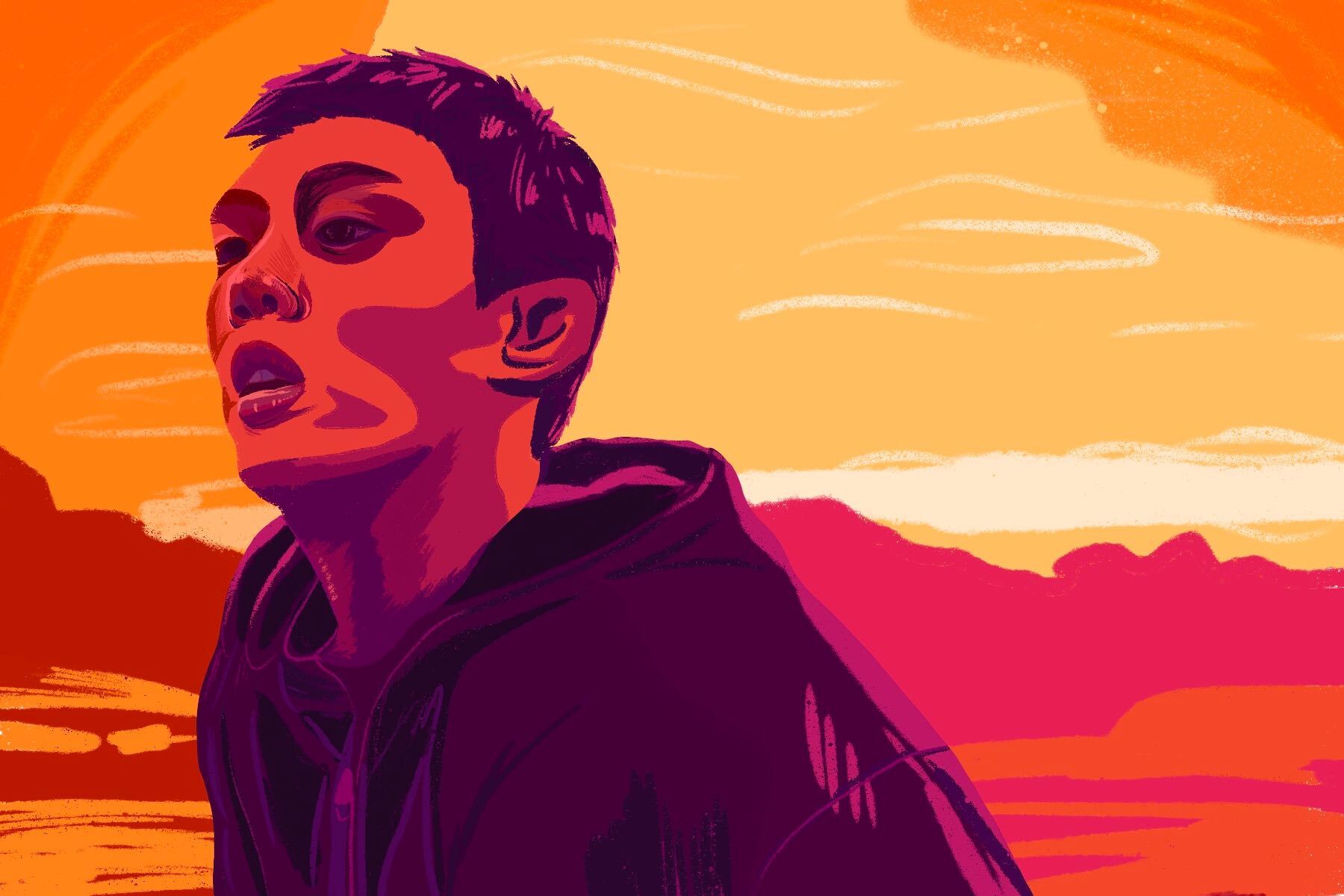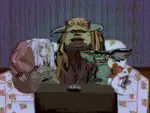A narrator who wants to write. A girl who peels an invisible tangerine. A well-traveled man who drives a silver sports car. These three characters exist in the Haruki Murakami short story “Barn Burning” and its film adaptation, “Burning,” directed by Lee Chang-dong.
When I saw that the movie “Burning” was based on a Murakami short story, I was apprehensive to see how Murakami’s narrative writing style would translate on screen. Murakami is known for making mundane everyday activities seem eerie, creating an atmosphere where we are patiently waiting for very little to happen, while subconsciously knowing that underneath the surface of the text, something very dark is going on. Even though there are some pretty significant differences between the story and the movie, Lee Chang-dong’s film does a phenomenal job of translating this fundamental feeling of unease to the screen.
The short story “Barn Burning” is narrated by a neutral, nameless, Nick Carraway-esque narrator. The narrator, who is also an aspiring writer, is friends with a similarly nameless girl. She is young, works occasionally as a part-time model, is learning pantomime and is described as having a strangely calming yet free-spirited character. She takes a trip to Africa on a whim and when she comes back three months later, the narrator goes to pick her up from the airport, meeting her new boyfriend.
One day, the girl and her boyfriend stop by the narrator’s house. They drink some beer, smoke some weed and when the girl dozes off, the boyfriend tells the narrator that he burns barns, talking about it as a kind of perverse yet cathartic hobby. Weeks later, the girl seems to have disappeared, and the narrator waits for a barn to burn down near his house while searching for his friend.
With such a bare-bones plot, the impact of the story comes from the ability of Murakami to make the reader doubt everything they have just read. After my first listen via the New Yorker Fiction Podcast’s reading of the short story, it felt as if I had missed something, just like the narrator misses the boyfriend’s metaphor for barn burning. This sort of ambiguity, the feeling that something sinister has happened but not exactly being able to put a finger on it, pervades every line of the story.
For instance, the true nature of the relationship between the narrator and the girl is obscure. It is possible that their relationship wasn’t platonic even though the narrator mentions that he has a wife. He picks up the girl and her boyfriend after she returns from Africa, and he comments offhandedly, “I had no idea why I’d gone to all the trouble of coming out to the airport.” As with almost all parts of the story, this line can be read in many different ways. The narrator could literally just be wondering why he spent all this time hanging out as a third wheel for his friend and her boyfriend, or it could be read with an undertone of frustration, and possibly even jealousy. The first-person perspective of the Murakami piece thinly masks the narrator’s true feelings.
Yet, this sense of jealousy for the boyfriend dissipates, for the most part. It’s as if the narrator’s neutrality slips for just a moment. Even as the narrator and the boyfriend talk and smoke, the inflections of their conversation seem indifferent and objective, but the topic of conversation — the boyfriend’s hobby of burning down barns — is undeniably ominous and unsettling.
Later, the narrator goes and researches all the barns in his area and monitors them meticulously, waiting to catch the barn burning in action. His extra attention to the barns doesn’t seem strange until you realize how obsessive the narrator’s fixation on them has become. The writing style of Murakami often portrays things as objective, narrating things “how they are,” but the unspoken narrative lies between the lines. The ambiguity of the true nature of the relationships, people and their actions leaves us wondering what exactly has happened.
The greatest and most terrifying uncertainty of the story comes from the story’s title, “Barn Burning,” which can be read as a metaphor for a serial killer’s hobby: murder. When the boyfriend tells the narrator that his next burning is “very close by,” we assume he means he will burn a barn close to the narrator’s home. But later, when the girl disappears and no barns near the narrator’s house have burned down, we realize the boyfriend spoke with double meaning. He even mentions that his hobby of barn burning sustains his idea of “morality [as] the delicate balance that’s involved in parallel existence,” possibly hinting that even what he’s saying isn’t what he really means.
The boyfriend says he chooses barns that “no one gets choked up about,” which could refer to people that are isolated and easy to take advantage of, like the girl who can be used to symbolize universal, foolhardy innocence. The boyfriend even mentions, during his last interaction with the narrator, that the girl didn’t have “any real friends,” except the narrator.
The boyfriend’s character can be read as a manifestation of universal evil. He doesn’t burn his own barns; it’s the pleasure of being able to take something away from someone else, like the girl from the narrator, that makes the act so wicked. When the narrator asks him about the morality of burning and destroying other people’s property, the boyfriend says, “I don’t judge anything. The barns are waiting to be burned. I just accept that. I merely accept what’s there.”
The boyfriend’s indifferent and amoral stance makes his hobby of barn burning seem even more sinister, as if something that society sees as bad or unlawful is actually just a naturally occurring, inevitable event. In this way, the boyfriend represents the banality of evil, its cruel destruction and our inability to stop it. This feeling of helplessness is conveyed in the last line when the narrator realizes his ignorance far too late: “No barn in my neighborhood has burned down. And I haven’t heard about any barn burning. December’s come again, and the winter birds fly overhead. And I keep on getting older.”
When I watched the 148-minute long film adaptation, “Burning,” I was initially upset at the liberties Lee Chang-dong took with the Murakami story, straying radically far from the original story in some aspects. Yet I couldn’t deny that the essential Murakami “strangeness in the mundane” atmosphere was preserved in the story’s translation to screen. The film’s power comes after viewing it; it takes a moment for your brain to digest the fiery, vengeful ending. From there, you can backtrack and revel in the masterfully scripted slow-burn build up.
Because the film medium relies heavily on visual plot- and character-driven scenes, Lee Chang-dong fleshes out Murakami’s original characters — the narrator, the girl and the boyfriend — by giving them the names Jongsu, Haemi and Ben, respectively. Another change from the original Murakami short story is the title. Lee’s film was renamed to “Burning” to remain true to its location in Korea: Korea does not have barns, forcing the film to change Ben’s hobby to burning greenhouses rather than barns, and subsequently altering the title.
Without the bias of first-person narration seen in the Murakami piece, the love triangle is placed at the forefront of the movie, along with commentary on South Korean millennial discontent. While the narrator in the original short story was just a mouthpiece, the film’s depiction of Jongsu, played by the talented Yoo Ah-in, becomes an active force in the movie. He is a character with a complicated history and even more complicated emotions.
As a young Korean college graduate aspiring to write his first novel, Jongsu is trapped in his menial delivery job. His face is stuck in a constant blank expression, though we find out later that it’s just a facade to his inherited rage. He is tied down to his small rural village of Paju because his father was convicted of a violent crime and he has to come back to take care of the family’s crummy estate. The only part of his life that he has agency over is his relationship with Haemi; he takes care of her cat, Boil, hangs out with her new boyfriend and his snobby friends, and entertains her fixation on Little Hunger and Great Hunger.
Haemi, on the other hand, takes on the “manic pixie” girl trope within the film. She first encounters Jongsu when she’s at work, dancing in a pink miniskirt as an advertisement sales girl. Jongsu doesn’t seem to remember her even though she says that they went to the same school and even lived next to each other as kids.
They get food together, and she tells him she’s learning to mime and performs for him. Her hands peel the skin of a tangerine that isn’t there and she pops the pretend slices in her mouth, chews and spits out the nonexistent seeds, explaining that “What you do isn’t make yourself believe that there are tangerines there. You just have to forget that the tangerines aren’t there.” This line is crucial in defining the way we see the movie; what we see isn’t necessarily the reality, and what we don’t see, our minds conjure up.
While she mimes eating tangerines, she tells Jongsu about traveling to Africa to better understand Little Hunger and Great Hunger. She explains that Little Hunger is when people are physically hungry, but Great Hunger is a hunger for the meaning of life. Haemi seems to embody Little Hunger; she is easily entertained by the shallowness of millennial life, working a meaningless job, traveling on a whim, yet she cries while talking about a sunset. It almost seems as if she feels like she should want more, to be the Great Hunger, but can’t. Jongsu, on the other hand, as a writer, pursues Great Hunger, wanting to understand Haemi and the world, but is held back by his inescapable working class status.
The third point of the love triangle is Ben, a foil to Jongsu in every way possible. Played by Korean American actor Steven Yeun, Ben has a foreign — but not too foreign — vibe, drives a silver sports car, says he “plays” for a living, and has Haemi in the palm of his hand, to Jongsu’s dismay. Ben represents everything Jongsu doesn’t have but wants: money, a nice car and the girl he likes. While Ben is full of empty polite smiles, all underlaid by quiet condescension toward Jongsu, Jongsu suffers from his inherited silent rage that is almost imperceptible during their awkward encounters until his violent outburst at the end of the movie. After becoming convinced that Ben killed Haemi after realizing what his “greenhouse burning” hobby may symbolize, Jongsu transfers his obsession from Haemi onto Ben.
Another significant difference between the story and the film is the presence of Haemi’s cat, Boil, who takes on a Schrodinger’s cat kind of character. After hooking up with Haemi once, Jongsu unthinkingly agrees to take care of her cat while she’s in Africa. Yet, every time he comes to feed the cat and change the litter, he never sees the cat itself, only its used litter and empty food bowl. He starts to wonder if it even exists at all. After Haemi disappears, suddenly Ben owns a cat that coincidentally responds to the name Boil.
Along with the class tensions between Jongsu and Ben, the multitudes of mysterious phone calls Jongsu gets at his house, and Haemi’s last dance scene, the film heaps layers upon layers of meaning, capturing the metaphysical narrative of Murakami in a visually compelling, suspenseful mystery. Amidst the doubt the film forces us to endure, the tangible, absolute destruction at the end of the film is absurd and fantastic in its divergence from the book.
Both the story and the movie do an amazing job of capturing ambiguity and uncertainty. All we are given is a thin veil of objective facts that can be read a hundred different ways. We are plagued with multiple realities, multiple layers — none of them certain. The only thing we are left with is knowing that there is no right or wrong, no Little Hunger or Great Hunger, no love or death; it all exists and doesn’t exist all at once.

















